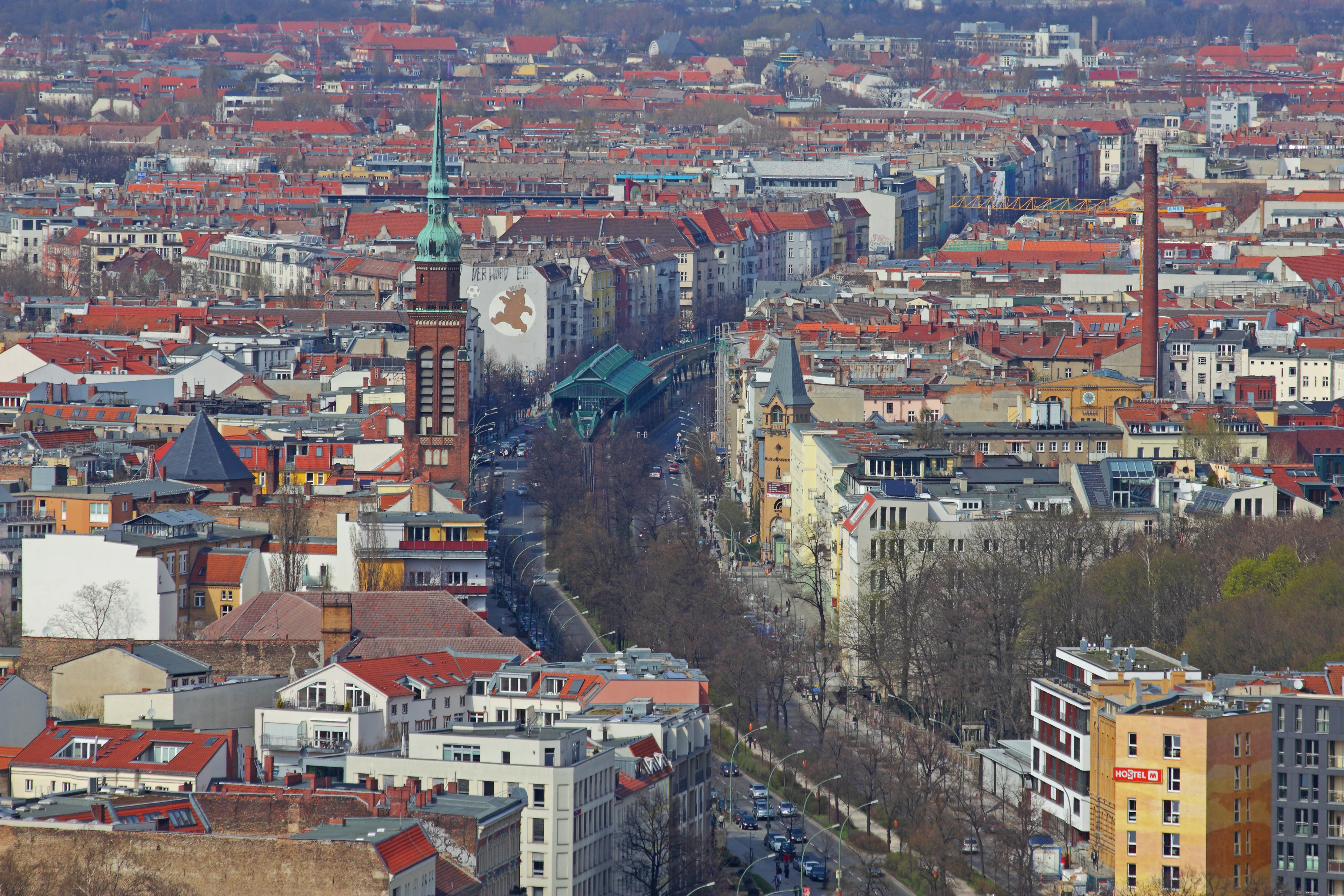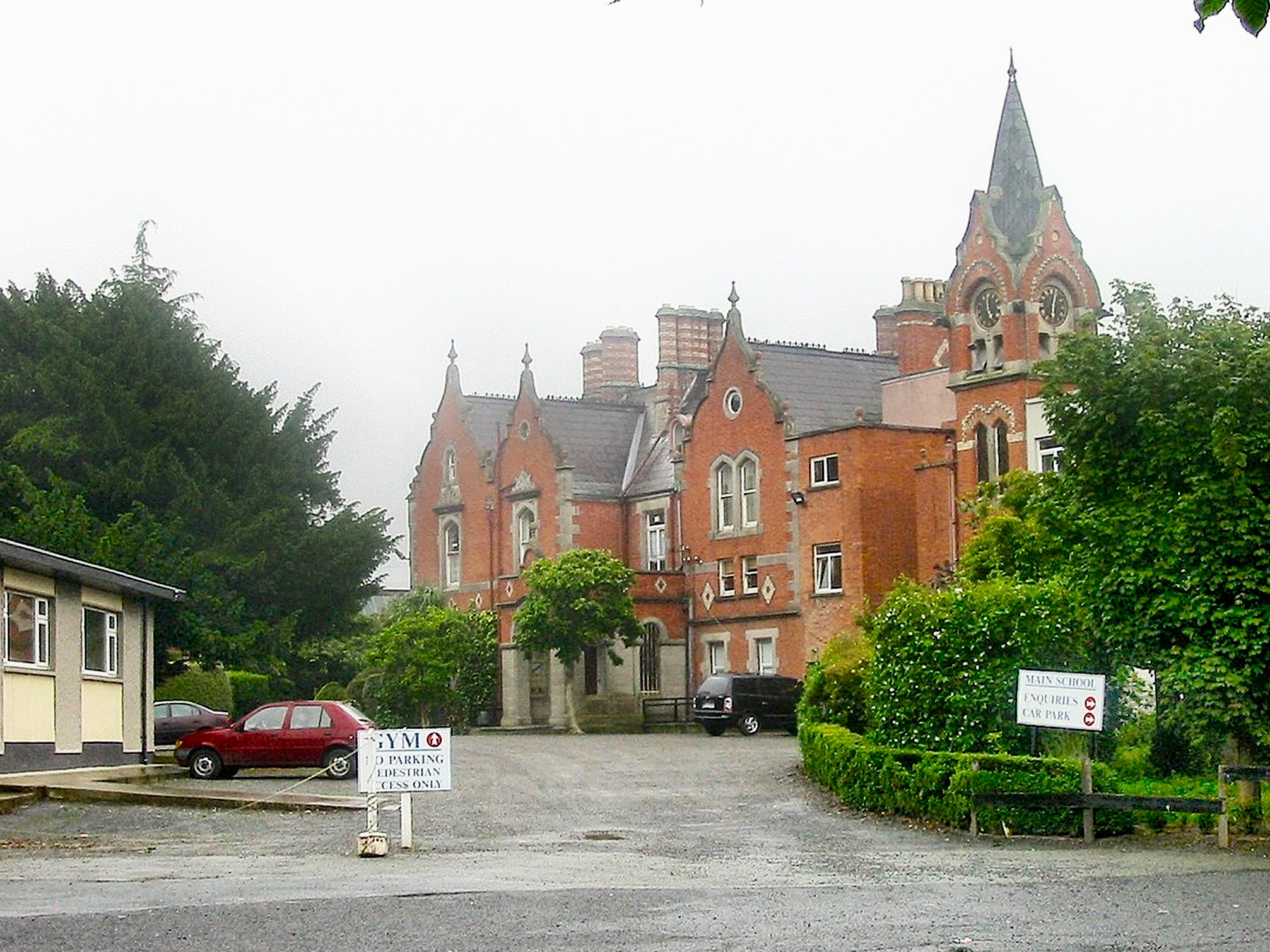|
Eberswalder Straße (Berlin U-Bahn)
Eberswalder Straße is an overground station located on the line of the Berlin U-Bahn network. It is located in the Prenzlauer Berg area of the city on Schönhauser Allee, a major street running from the city centre north towards Pankow. The station is a raised iron structure on stone columns, designed by architect Alfred Grenander. History The station opened in 1913 as Danziger Straße. It was severely damaged in December 1943 and was also closed during the last months of World War II. The post-war division of Berlin put it in the Russian sector. In 1950 it was renamed Dimitroffstrasse, in honour of Bulgarian communist leader Georgi Dimitrov who had died in the previous year. In 1991, following the reunification of Germany, the station's name was changed in order to remove its political links. The station was named Eberswalder Straße, a street that crosses Schönhauser Allee very nearby. A local landmark below the elevated tracks at the south end of the station is ''Konno ... [...More Info...] [...Related Items...] OR: [Wikipedia] [Google] [Baidu] |
Berlin U-Bahnhof Eberswalder Straße 2001
Berlin ( ; ) is the Capital of Germany, capital and largest city of Germany, by both area and List of cities in Germany by population, population. With 3.7 million inhabitants, it has the List of cities in the European Union by population within city limits, highest population within its city limits of any city in the European Union. The city is also one of the states of Germany, being the List of German states by area, third smallest state in the country by area. Berlin is surrounded by the state of Brandenburg, and Brandenburg's capital Potsdam is nearby. The urban area of Berlin has a population of over 4.6 million and is therefore the most populous urban area in Germany. The Berlin/Brandenburg Metropolitan Region, Berlin-Brandenburg capital region has around 6.2 million inhabitants and is Germany's second-largest metropolitan region after the Rhine-Ruhr region, as well as the List of EU metropolitan areas by GDP, fifth-biggest metropolitan region by GDP in the European Union. ... [...More Info...] [...Related Items...] OR: [Wikipedia] [Google] [Baidu] |
List Of Berlin U-Bahn Stations
This is an alphabetical list of Berlin U-Bahn stations. Currently, there are 175 active stations. A B C D E F G H I J K L M N O P R S T U V W Y Z References {{Public transport in Berlin Berlin U-Bahn stations, Berlin-related lists, Railway stations (U-Bahn) Lists of metro stations, Berlin U-Bahn stations, List of Lists of railway stations in Germany, Berlin ... [...More Info...] [...Related Items...] OR: [Wikipedia] [Google] [Baidu] |
Berlin U-Bahn
The Berlin U-Bahn (; short for , "underground railway") is a rapid transit system in Berlin, the capital and largest city of Germany, and a major part of the city's public transport system. Together with the Berlin S-Bahn, S-Bahn, a network of suburban train lines, and a Trams in Berlin, tram network that operates mostly in the eastern parts of the city, it serves as the main means of transport in the capital. Opened in 1902, the serves List of Berlin U-Bahn stations, 175 stations spread across nine lines, with a total track length of , about 80% of which is underground. Trains run every two to five minutes during peak hours, every five minutes for the rest of the day and every ten minutes in the evening. Over the course of a year, U-Bahn trains travel , and carry over 400 million passengers. In 2017, 553.1 million passengers rode the U-Bahn. The entire system is maintained and operated by the , commonly known as the BVG. Designed to alleviate traffic flowing into and out of c ... [...More Info...] [...Related Items...] OR: [Wikipedia] [Google] [Baidu] |
Prenzlauer Berg
Prenzlauer Berg () is a Boroughs and localities of Berlin, locality of Berlin, forming the southerly and most urban district of the borough of Pankow. From its founding in 1920 until 2001, Prenzlauer Berg was a district of Berlin in its own right. However, that year it was incorporated (along with the borough of Berlin-Weißensee, Weißensee) into the greater district of Pankow. From the 1960s onward, Prenzlauer Berg was associated with proponents of East Germany's diverse counterculture including Christian activists, Bohemianism, bohemians, state-independent artists, and the gay community. It was an important site for the peaceful revolution that brought down the Berlin Wall in 1989. In the 1990s the borough was also home to a vibrant squatting scene. It has since experienced rapid gentrification. Geography Prenzlauer Berg is a portion of the Pankow district in northeast Berlin. To the west and southwest it borders Mitte, to the South Friedrichshain-Kreuzberg, to the east Lich ... [...More Info...] [...Related Items...] OR: [Wikipedia] [Google] [Baidu] |
Schönhauser Allee
Schönhauser Allee in Berlin is one of the most important streets of the Prenzlauer Berg district. Schönhauser Allee begins at Rosa-Luxemburg-Platz in the south and ends at Schonensche Straße in the north. Many of the side streets of Schönhauser Allee are named after Scandinavian cities as Bornholmer Straße and Kopenhagener Straße. The street was named after the Schönhausen Palace in Pankow. The Berlin U-Bahn line U2 follows the boulevard on an elevated railway An elevated railway or elevated train (also known as an el train or el for short) is a railway with the Track (rail transport), tracks above street level on a viaduct or other elevated structure (usually constructed from steel, cast iron, concre .... References Pankow Shopping districts and streets in Germany Streets in Berlin {{Germany-road-stub ... [...More Info...] [...Related Items...] OR: [Wikipedia] [Google] [Baidu] |
Pankow
Pankow () is the second largest and most populous Boroughs and quarters of Berlin, borough of the German capital Berlin. In Berlin's 2001 administrative reform, it was merged with the former boroughs of Prenzlauer Berg and Weissensee (Berlin), Weißensee; the resulting borough retained the name Pankow. Pankow was sometimes claimed by the Western Allies (United States, United Kingdom, and France) to be the capital of the German Democratic Republic (East Germany), while the German Democratic Republic itself considered East Berlin to be its capital. Overview The borough, named after the Panke river, covers the northeast of the city region, including the inner city locality of Prenzlauer Berg. It borders Mitte and Reinickendorf in the west, Friedrichshain-Kreuzberg in the south, and Lichtenberg, Berlin, Lichtenberg in the east. Pankow is Berlin's largest borough by population and the second largest by area (after Treptow-Köpenick). Between 1945 and 1960, Schönhausen Palace and the ... [...More Info...] [...Related Items...] OR: [Wikipedia] [Google] [Baidu] |
Alfred Grenander
Alfred Frederik Elias Grenander (26 June 1863 – 14 March 1931) was a Swedish architect, who became one of the most prominent engineers during the first building period of the Berlin U-Bahn network in the early twentieth century. Biography Grenander was born at Skövde in Västra Götaland County, Sweden. He was raised in Stockholm and began studying at the Swedish Royal Institute of Technology in 1881. He changed to the ''Königliche Technische Hochschule'' in Charlottenburg (now Technische Universität Berlin) in 1885. After his final degree in 1890 he became a site engineer at the construction of the new Reichstag building under the direction of Paul Wallot and continued his career in the architectural office of Alfred Messel. In 1896 Grenander set up his own business and worked as a designer of the ''Hochbahngesellschaft'', an affiliate of Siemens & Halske established in 1897 to build the first U-Bahn elevated railway of Berlin, opened in 1902. Up to 1931, he constructed a ... [...More Info...] [...Related Items...] OR: [Wikipedia] [Google] [Baidu] |
Bulgaria
Bulgaria, officially the Republic of Bulgaria, is a country in Southeast Europe. It is situated on the eastern portion of the Balkans directly south of the Danube river and west of the Black Sea. Bulgaria is bordered by Greece and Turkey to the south, Serbia and North Macedonia to the west, and Romania to the north. It covers a territory of and is the tenth largest within the European Union and the List of European countries by area, sixteenth-largest country in Europe by area. Sofia is the nation's capital and List of cities and towns in Bulgaria, largest city; other major cities include Burgas, Plovdiv, and Varna, Bulgaria, Varna. One of the earliest societies in the lands of modern-day Bulgaria was the Karanovo culture (6,500 BC). In the 6th to 3rd century BC, the region was a battleground for ancient Thracians, Persians, Celts and Ancient Macedonians, Macedonians; stability came when the Roman Empire conquered the region in AD 45. After the Roman state splintered, trib ... [...More Info...] [...Related Items...] OR: [Wikipedia] [Google] [Baidu] |
Georgi Dimitrov
Georgi Dimitrov Mihaylov (; ) also known as Georgiy Mihaylovich Dimitrov (; 18 June 1882 – 2 July 1949), was a Bulgarian communist politician who served as General Secretary of the Central Committee of the Bulgarian Communist Party from 1933 to 1949, and the first leader of the Communist People's Republic of Bulgaria from 1946 to 1949. From 1935 to 1943, he was the General Secretary of the Communist International. Born in western Bulgaria, Dimitrov worked as a printer and trade unionist during his youth. He was elected to the National Assembly (Bulgaria), Bulgarian parliament as a socialist during the World War I, First World War and campaigned against his country's involvement in the conflict, which led to his brief imprisonment for sedition. In 1919, he helped found the Bulgarian Communist Party. Two years later, he moved to the Soviet Union and was elected to the executive committee of Profintern. In 1923, Dimitrov led a September Uprising, failed communist uprising against ... [...More Info...] [...Related Items...] OR: [Wikipedia] [Google] [Baidu] |
Currywurst
''Currywurst'' () is a fast food dish of German origin consisting of sausage with curry ketchup. It was invented in 1949 by Herta Heuwer, who began selling it at a food stand in West Berlin. The Deutsches Currywurst Museum estimated that 800 million currywursts are eaten every year in Germany, with 70 million in Berlin alone. History The invention of currywurst is attributed to Herta Heuwer in Berlin in 1949, after she obtained ketchup, or possibly Worcestershire sauce, and curry powder from British soldiers in Germany. She mixed these ingredients with other spices and poured them over grilled pork sausage. Heuwer started selling them at a stand in Charlottenburg, where it became popular with construction workers rebuilding the devastated city. Heuwer patented her sauce under the name Chillup in 1951. At its height the stand was selling 10,000 servings per week. She later opened a small restaurant which operated until 1974. Today, is often sold as a take-away fo ... [...More Info...] [...Related Items...] OR: [Wikipedia] [Google] [Baidu] |
U2 (Berlin U-Bahn) Stations
U2 are an Irish rock band formed in Dublin in 1976. The group comprises Bono (lead vocals and rhythm guitar), the Edge (lead guitar, keyboards, and backing vocals), Adam Clayton (bass guitar), and Larry Mullen Jr. (drums and percussion). Initially rooted in post-punk, U2's musical style has evolved throughout their career, yet has maintained an anthemic quality built on Bono's expressive vocals and the Edge's chiming, effects-based guitar sounds. Bono's lyrics, often embellished with spiritual imagery, focus on personal and sociopolitical themes. Popular for their live performances, the group have staged several elaborate tours over their career. The band was formed when the members were teenaged pupils of Mount Temple Comprehensive School and had limited musical proficiency. Within four years, they signed with Island Records and released their debut album, ''Boy'' (1980). Works such as their first UK number-one album, ''War'' (1983), and singles "Sunday Bloody Sunday" and "Pr ... [...More Info...] [...Related Items...] OR: [Wikipedia] [Google] [Baidu] |





